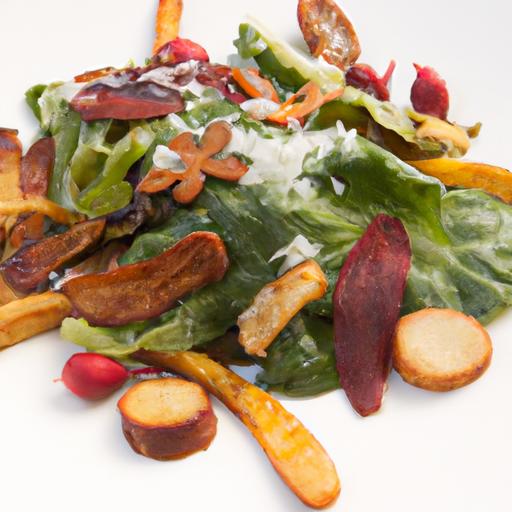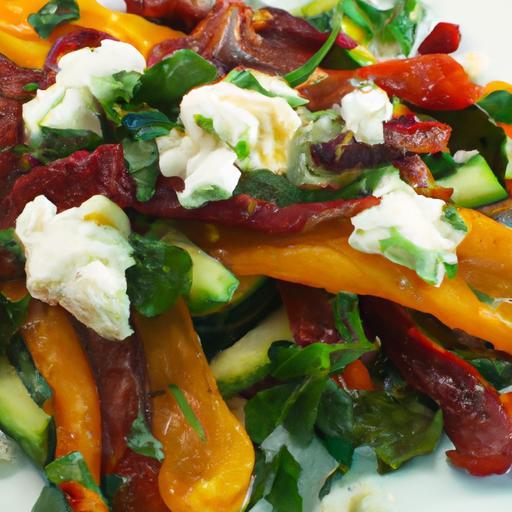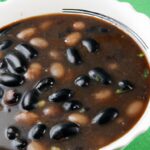There’s something undeniably magical about roasted vegetables-the way simple roots and greens transform into crisp, caramelized gems bursting with deep, savory flavor. Yet achieving that perfect balance of tender inside and golden, crispy edges can feel elusive. In Crisp & Perfect: Mastering the Art of Roasted Veggies, we’ll unlock the secrets behind this culinary alchemy, from selecting the freshest produce to mastering temperature and timing. Whether you’re a kitchen novice or a seasoned cook, get ready to elevate humble veggies into show-stopping dishes that sing with texture, color, and irresistible taste.
Crisp & Perfect: Mastering the Art of Roasted Veggies
Mastering the art of roasted veggies unlocks a world where texture meets flavor in harmony, transforming humble vegetables into crisp, caramelized bites that delight the senses. This journey invites home cooks to embrace the science and secrets behind roasting, ensuring each vegetable emerges golden and irresistibly crunchy. Whether you’re new to roasting or seeking to refine your technique, these insights elevate your kitchen confidence and turn every roast into a stunning culinary triumph.
Prep and Cook Time
- Preparation: 15 minutes
- Cooking: 25-35 minutes (depending on vegetable and size)
- Total Time: 40-50 minutes
Yield
- Serves 4 generously as a side dish
Difficulty Level
- Easy – perfect for cooks of all skill levels
Ingredients
- 4 cups mixed vegetables (carrots, Brussels sprouts, cauliflower, and sweet potatoes), chopped into uniform bite-size pieces
- 3 tbsp extra virgin olive oil
- 1 tsp sea salt
- ½ tsp freshly ground black pepper
- 1 tsp garlic powder
- 1 tsp smoked paprika
- 1 tbsp fresh thyme leaves (optional)
- 1 tbsp balsamic vinegar (optional, for finishing)
Instructions
- Preheat your oven to 425°F (220°C). This higher temperature is key for achieving the sought-after crisp & perfect texture, promoting Maillard browning without drying the veggies out.
- Prepare the vegetables by washing and cutting into similar-size pieces. Uniformity ensures even roasting and consistent crispiness throughout.
- Toss the vegetables in a large bowl with extra virgin olive oil until lightly and evenly coated. Oil acts as a heat conductor and crisp promoter by aiding caramelization.
- Sprinkle the seasoning mix (sea salt, black pepper, garlic powder, and smoked paprika) evenly over the oiled veggies. The paprika deepens the roasted flavor while garlic powder adds subtle warmth.
- Arrange vegetables in a single layer on a rimmed baking sheet lined with parchment paper. Avoid overcrowding – leaving space allows hot air to circulate, creating that coveted crunch.
- Roast for 25-35 minutes, turning halfway through. Watch closely after 20 minutes, as different veggies brown at varying speeds; carrots and sweet potatoes may take longer than Brussels sprouts.
- Optional finishing touches: Once out of the oven, toss the roasted vegetables gently with fresh thyme leaves and a splash of balsamic vinegar to add brightness and depth.
Chef’s Notes for Success
- Choosing Vegetables: Starchy roots like sweet potatoes and carrots crisp beautifully, while high-water content veggies like zucchini roast best sliced thin or at high temperature for shorter times.
- Seasoning Variations: Experiment with cumin, coriander, or za’atar for a global twist. A sprinkle of grated Parmesan or nutritional yeast right before serving adds savory umami.
- Even Roasting: Use multiple baking sheets if needed rather than crowding one pan. Rotate pans halfway through if using multiple racks in your oven.
- Make-Ahead: Vegetables can be pre-chopped and stored in water in the fridge up to 24 hours, reducing prep time on roast day.
- Prevent Sogginess: Let vegetables dry completely after washing; moisture is the enemy of crispness.
Serving Suggestions
Roasted vegetables reach their peak when served warm and slightly crisp on the edges. Garnish with freshly chopped herbs like parsley or chives for vibrancy and flavor contrast. Pair them alongside grilled proteins, swirl into salads, or fold into grain bowls. Drizzle a dollop of garlic aioli or tangy tahini sauce for an extra indulgent touch. For a rustic twist, serve on a wooden board with crusty bread and a sprinkle of flaked sea salt right before serving to highlight the texture.
| Macro Nutrient | Per Serving |
|---|---|
| Calories | 150 kcal |
| Protein | 3 g |
| Carbohydrates | 24 g |
| Fat | 7 g |

For further inspiration on cooking techniques and vegetable selection, check out our Ultimate Vegetable Roasting Guide. To deepen your understanding of the Maillard reaction, explore this scientific resource.
Q&A
Q&A: Crisp & Perfect – Mastering the Art of Roasted Veggies
Q1: Why are roasted vegetables such a beloved side dish?
A: Roasted veggies have a magical transformation-they turn humble raw produce into caramelized nuggets of flavor. The dry heat concentrates their natural sugars, creating a perfect balance of crispy edges and tender insides that delight every bite.
Q2: What’s the secret to getting vegetables crisp without turning them into mush?
A: The key lies in balance and technique. Start with high heat-around 425°F (220°C)-to encourage browning. Use a light coating of oil to foster crispiness, but don’t overdo it, or the veggies will steam instead of roast. Also, give them space on the tray; overcrowding traps moisture and leads to soggy results.
Q3: How do you pick the best vegetables for roasting?
A: Almost any vegetable loves the oven’s embrace! Root veggies like carrots, sweet potatoes, and beets shine brilliantly. Brassicas such as Brussels sprouts and cauliflower get delightfully crispy. Even softer veggies like zucchini or cherry tomatoes can roast beautifully if added toward the end of cooking to avoid mushiness.
Q4: Can seasoning really make or break roasted veggies?
A: Absolutely! Salt is your first friend-it draws out moisture to help crisp edges and enhances flavor. Beyond that, a sprinkle of black pepper, garlic powder, fresh herbs, or even a dash of smoked paprika takes your veggies from simple to spectacular. Experimentation is encouraged: a zing of lemon zest or a drizzle of balsamic glaze can be transformative.
Q5: How do you know when your roasted veggies are done?
A: Look for golden, caramelized edges with a tender yet firm interior. They should have a slight crunch but be easy to pierce with a fork. Timing varies-denser veggies take longer, so stagger cooking times or remove delicate ones earlier to achieve perfect results.
Q6: Any tips for roasting veggies ahead of time?
A: Roast veggies fully cooled, then store them airtight in the fridge. To refresh their crispness, reheat quickly in a hot oven or a skillet-avoid the microwave, which can make them soggy. This makes weeknight meals easier while keeping your veggies crave-worthy.
Q7: Can roasting vegetables be a healthy cooking option?
A: Definitely! Roasting uses minimal oil, preserves nutrients better than boiling, and highlights vegetables’ natural flavors-reducing the need for heavy sauces or salt. Plus, the satisfying texture makes you more likely to enjoy and eat your greens, a win for wellness.
Q8: Any creative twists to upgrade roasted veggies from side dish to star?
A: Sprinkle with toasted nuts, crumbled cheese, or fresh herbs after roasting. Toss with grains or beans for a hearty salad. Or add a finishing drizzle of infused oils or flavored vinegars. Roasted veggies aren’t just a side-they’re your canvas for culinary creativity!
Concluding Remarks
As the final sizzle fades and the irresistible aroma of perfectly roasted veggies fills your kitchen, you’ve unlocked a culinary secret: achieving crisp, caramelized edges and tender, flavorful hearts isn’t just a happy accident-it’s an art. With the right balance of heat, seasoning, and technique, roasting transforms humble vegetables into show-stopping stars of any meal. So next time you fire up the oven, remember these tips and embrace the magic of the roast. Your taste buds-and maybe even your dinner guests-will thank you for turning simple veggies into pure perfection. Happy roasting!








